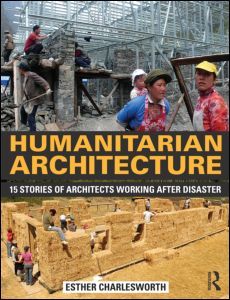Humanitarian Architecture 15 stories of architects working after disaster
Auteur : Charlesworth Esther

Never has the demand been so urgent for architects to respond to the design and planning challenges of rebuilding post-disaster sites and cities. In 2011, more people were displaced by natural disasters (42 million) than by wars and armed conflicts. And yet the number of architects equipped to deal with rebuilding the aftermath of these floods, fires, earthquake, typhoons and tsunamis is chronically short.
This book documents and analyses the expanding role for architects in designing projects for communities after the event of a natural disaster. The fifteen case studies featured in the body of the book illustrate how architects can use spatial sensibility and integrated problem-solving skills to help alleviate both human and natural disasters. The cases include:
- Lizzie Babister - Department of International Development, UK.
- Shigeru Ban - Winner of The Pritzker Architecture Prize 2014, Shigeru Ban Architects and Voluntary Architects? Network, Japan.
- Eric Cesal ? Disaster Reconstruction and Resiliency Studio and Architecture for Humanity, Japan.
- Hsieh Ying Chun ? Atelier 3, Taiwan.
- Nathaniel Corum - Education Outreach and Architecture for Humanity, USA.
- Sandra D?Urzo - Shelter and Settlements and International Federation of the Red Cross and Red Crescent Societies, Switzerland.
- Brett Moore - World Vision International, Australia.
- Michael Murphy - MASS Design Group, USA.
- David Perkes - Gulf Coast Community Design Studio, USA.
- Paul Pholeros - Healthabitat, Australia.
- Patama Roonrakwit - Community Architects for Shelter and Environment, Thailand.
- Graham Saunders - International Federation of Red Cross and Red Crescent Societies, Switzerland.
- Kirtee Shah - Ahmedabad Study Action Group, India.
- Maggie Stephenson - UN-HABITAT, Haiti.
- Anna Wachtmeister - Catholic Organisation for Relief and Redevelopment Aid, the Netherlands.
The interviews and supporting essays show built environment professionals collaborating with post-disaster communities as facilitators, collaborators and negotiators of land, space and shelter, rather than as ?save the world? modernists, as often portrayed in the design media. The goal is social and physical reconstruction, as a collaborative process involving a damaged community and its local culture, environment and economy; not just shelter ?projects? that ?build? houses but leave no economic footprint or longer-term community infrastructure. What defines and unites the architects interviewed for Humanitarian Architecture is their collective belief that through a consultative process of spatial problem solving, the design profession can contribute in a significant way to the complex post-disaster challenge of rebuilding a city and its community.
Acknowledgements Foreword: Human Architecture – Michael Sorkin Introduction: A World of Disasters: The Rise and Rise of Humanitarian Architecture – Esther Charlesworth Part 1: Private Architecture Practice Based Humanitarian Architects 1. Voluntary Architect’s Network, Japan - Shigeru Ban 2. Atelier 3, Taiwan - Hsieh Ying-Chun 3. Mass Design Group, USA - Michael Murphy 4. Healthabitat, Australia - Paul Pholeros 5. Community Architects for Shelter and Environment (CASE), Thailand - Patama Roonrakwit Part 2: University-Research Based Humanitarian Architects 6. Architecture for Humanity, USA - Nathaniel Corum 7. Gulf Coast Community Design Studio, USA - David Perkes Part 3: NGO/International Aid Based Humanitarian Architects 8. Department of International Development, UK - Lizzie Babister 9. Architecture for Humanity, Japan - Eric Cesal 10. International Federation of the Red Cross and Red Crescent Societies (IFRC), Switzerland - Sandra D’Urzo 11. World Vision International, Australia - Brett Moore 12. International Federation of the Red Cross and Red Crescent Societies, Switzerland - Graham Saunders 13. Ahmedabad Study Action Group (ASAG), India - Kirtee Shah 14. UN-HABITAT, Haiti - Maggie Stephenson 15. Cordaid, The Netherlands - Anna Wachtmeister Part 4: Future Roles for the Humanitarian Architect Epilogue 1: Putting the public in design – Bryan Bell Epilogue 2: Architecture as service – Ian Davis Epilogue 3: Sending out an SOS – Rory Hyde Glossary Index.
Esther Charlesworth is the Founding Director of Architects without Frontiers (Australia), a design non-profit organization committed to working with communities in need. She is Associate Professor in Architecture and Design at RMIT University, Melbourne, Australia.
Date de parution : 06-2014
18.9x24.6 cm
Date de parution : 06-2014
18.9x24.6 cm
Thème de Humanitarian Architecture :
Mots-clés :
Young Men; Universitat Internacional De Catalunya; Beyond Shelter; Light Gauge Steel Frames; Design Like you Give a Damn; Gujarat State Disaster Management Authority; Design for the Other 90%; Public Interest Design; afh; Emergency Response Context; architecture for humanity; Villa Rosa; habitat for humanity; Paul Pholeros; disaster relief; Humanitarian Aid; humanitarian architecture; East Timor; Shigeru Ban; Hsieh Ying Chun; Michael Murphy; Mass Design Group; Straw Bale House; Patama Roonrakwit; Humanitarian Shelter; Nathaniel Corum; Mississippi State University; David Perkes; Broadmoor Neighbourhood; Lizzie Babister; Build Approach; Eric Cesal; Harvard University Graduate School; Sandra D'urzo; Pritzker Architecture Prize; Brett Moore; Mainstream Architectural Practice; Graham Saunders; Silpakorn University; Kirtee Shah; Temporary Housing Project; Maggie Stephenson; Netherlands Red Cross; Anna Wachtmeister; Oxfam GB; Bryan Bell; Ian Davis; Rory Hyde



